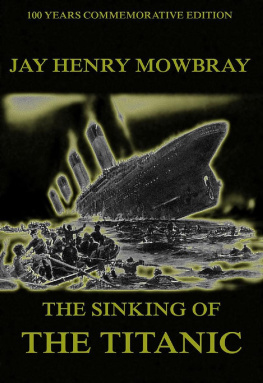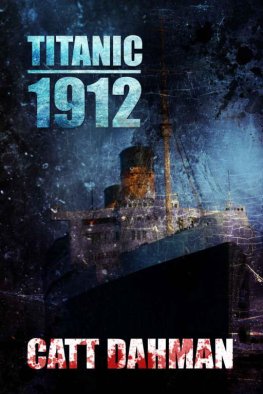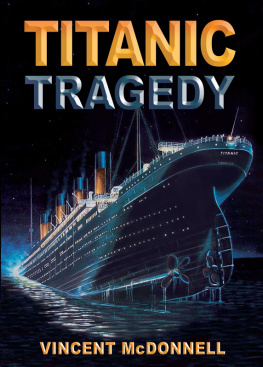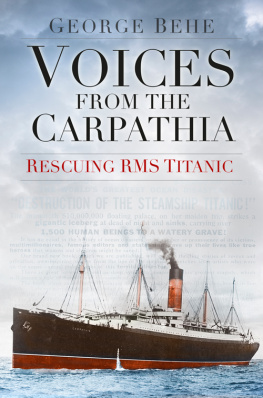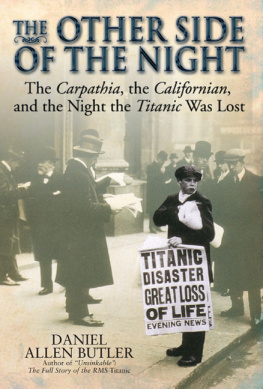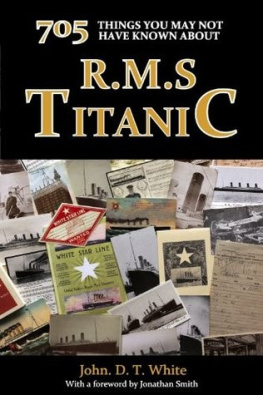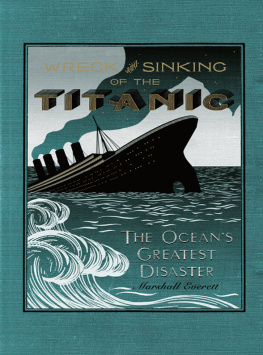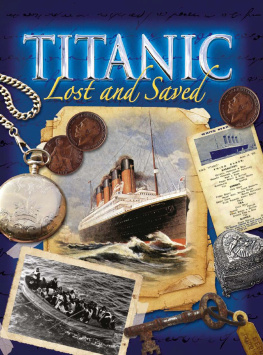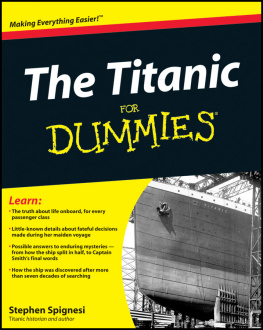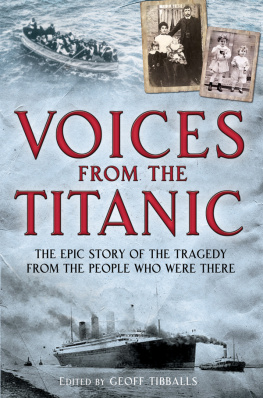The Sinking of The Titanic
Jay Henry Mowbray
Table of Contents:
The Sinking Of The Titanic, A. Gracie
Jazzybee Verlag Jrgen Beck
86450 Altenmnster, Germany
ISBN: 9783849621674
www.jazzybee-verlag.de
Steamships and Steamship Lines
It appears that self-moving vessels were first imagined by Roger Bacon, a learned monk of the Middle Ages. Though the application of steam-power to the propulsion of steam-vessels was once claimed for a Spaniard, Blasco de Garay, about 1540, it is now known that what he exhibited to Charles V. was simply a vessel with a paddle-wheel, worked by man-power. Papin's practical exhibit of a steam-vessel at Cassel (1707), was a success, but the vessel was only a model. It was the work of Newcomen and Hills in England, and Henry and others. In America, which furnished Fulton with the idea that earned him fame as the inventor of the "steam-boat." All these, with others besides, were experimenters of the latter part of the eighteenth century. In addition there was Runsey in Maryland and Fitch on the Delaware, the latter using on his boat both paddle-wheels and propeller. Symington built a steam towboat as early as 1801. Fulton's first experiments, made in France, were unsuccessful, and it was not until he secured a backer in Chancellor Livingston of New York, then American Ambassador to England, that he was able to buy a Boulton and Watt Engine in England to equip his "Clermont."
John Stevens of New York, was making even earlier attempts in this field, and it was not long after that first trip up the Hudson that the river and sound were covered with a fleet of steamboats. The first steamboat in British waters was the "Comet" on the Clyde, 1812. The first steam-vessel to cross the Atlantic was the "Savannah," 1819. She was a sailing vessel using steam as an auxiliary power, and she made the passage to Liverpool in 31 days, 8 of which were under steam. In 1825, one Captain Johnson, was awarded 10,000 ($50,000) in England for taking the first steam-vessel to India. About this time, the "Royal William," of Quebec crossed the ocean under steam in 21 days. In 1837, Ericsson (q. v.), later the builder of the "Monitor." Constructed in England the first screw-propeller. Regular transatlantic traffic by steamships was inaugurated by the " Sirius" which made the voyage from Queenstown to New York in 1838. The Cunard Line, the first regular line, was started in 1840: the same year the first war steamer was built. The Collins Line, a rival of the Cunard, was organized in 1848. and the following year, 1853, the Inman and the Allan Lines. The Guion Line began business in 1864. The Cunard Line still flourishes, though most of its old time rivals are gone. The principal lines in the transatlantic service of the early 20 th century were the Hamburg American, founded 1847: Anchor. 1852: North German Lloyd, 1857: French Line, 1800; White Star, 1870; Holland American, 1872; Red Star, 1873; Scandinavian American, 1879; Atlantic Transport and the American Line, 1892.
The following shows the size of some of these leviathans of their time: "Olympic," of the White Star Line, 45,000 gross tons: "Mauretania" and "Lusitania," Cunarders, 32,500 tons each; "Kaiserin Augusta Victoria," Hamburg American Line, 24,581 tons; the "George Washington," North German Lloyd Line. 27.000 tons. The "Great Eastern," built in 1859. Was 692 feet long of 80 feet beam and 22.800 tons displacement; the "Olympic" of was 882 feet long, 92 feet beam and 45,000 tons. In 1856 when the "Persia" made the passage from New York to Queenstown in 9 days, 10 hours, and 45 minutes, it was considered extraordinary. In 1910 the "Mauretania" made the trip from Queenstown to New York in 4 days, 10 hours and 41 minutes. The "Deutschland" ran out from New York to Naples in 7 days, 16 hours and 44 minutes, and the "City of New York" of the Pacific Mail Steamship Co., with Commander Philip of the Navy to navigate her, made the run from New York to San Francisco, 13.533 miles, without a stop in 54 days, 14 hours. The progress of ocean shipbuilding for size, speed and luxury was one of the extraordinary accomplishments of the age. In 60 years the speed of Atlantic steamships has increased from 8 to 25 knots: the power of marine engines from 700 to 70,000 horse power; length of vessels from 250 to 882 feet; boiler steam pressure from 13 to 250 pounds; gross tonnage from 1.200 to 45.000; while the length of time required for the passage has decreased from 15 days to less than five. Though not built for speed, the "Olympic's" time across the Atlantic is 5 days, 16 hours, 42 minutes. Some facts about this vessel are interesting. Largest plates employed in the hull were 36 feet long. Rudder, operated electrically, weighed 100 tons. There were more than 2,000 windows. There were 3,000.000 rivets, weighing 1,200 tons. There was an eighteen-hole golf course with hazards under the life-boats. There was a tennis and hand-ball court extending through two decks and 30 feet long. There were Turkish and electric baths and a salt water swimming pool of sufficient depth to permit diving. There were glass-enclosed decks, la carte restaurant, palm garden, veranda and a maids' and valets' salon. It had accommodation for 3,356 persons750 in the first class, 550 in
the second, 1.200 in the third, with 63 officers and sailors, 322 engineers, firemen, oilers, trimmers and machinists and 471 in the commissary department. The coal consumption of her 150 furnaces was 800 tons a day. The architects of the Hamburg-American and White Star Lines showed great rivalry in constructing ships greater and stronger every year. A common phrase was "unsinkable ships," and there seemed no limit to them. But the whole world was frightfully shocked when, in the night of April 14, 1912 the White Star steamer "Titanic " off Newfoundland plunged against an iceberg and sank within a few hours. Out of 2300 persons carried, only 700 were saved. The Epochs in Ocean Steamship Building to that time were: Wooden paddle wheels auxiliary to sails on ocean liners in 1819, giving increased speed. Iron hulls took the place of wood in 1843, producing stronger construction. Screw propellers supplanted paddles in 1850, permitting greater economy of operation. Compound engines replaced the simple form in 1856, economizing fuel and increasing power. Steel hulls instead of iron were first used in 1879, lowering the oost of construction. Twin screws were adopted in 1889, giving greater safety and diminishing the liability to serious accident. Wireless telegraphby the Marconi systempermitting communication between ship and shore, or between ships at sea distant from each other, now extending 1,000 miles, was adopted in 1901 by the principal transatlantic steamship lines. Turbine engines Parsons systementirely obviating vibration was adopted by the Cunard Line In 1905, the first great transatlantic liner thus equipped being the "Germania," which was placed in the Cunard service in that year.
The Sinking of The Titanic
PREFACE
"WE are as near Heaven by sea as by land," cried Sir Humphrey Gilbert, ere his ship sank with him; and the hundreds who perished in the ocean within reach of the exultant welcome and the festal preparation of the shore have found Paradise as surely, and in giving "the last full measure of devotion"
have gone as brave men would wish to go. Sorrow that is too deep and strong for words clutches the heart-strings of humanity and the Nation mourns for the heroic dead, who were carried down into the sea with the crushed "Titanic." They faced death with high hearts, making the Supreme Sacrifice so that the women and the helpless little ones might live.
It is a heart-rending story, redeemed and ennobled by the heroism of the victims. Its details are appalling.
The world is full of mournings for the dead. Nature has conquered again, destroying with ruthless hand the most marvelous ship that ever floated on the bosom of the deep. It is the worst disaster that ever befell any vessel. It is the wrecking of a whole armada within one hull of steel, vaunted as unsinkable.
Next page
